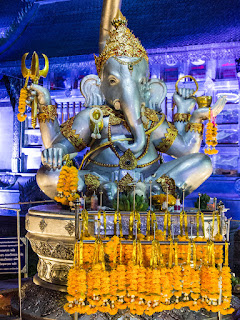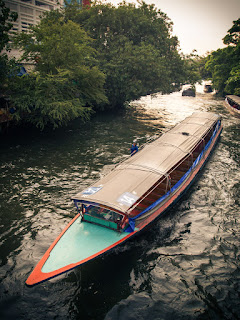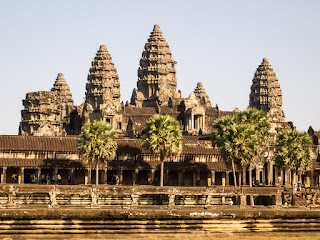Lying on a mattress in my bamboo shack I could hear geckos
slap their tails against the bamboo walls.
From the rooftop bar across the patio, I could hear the thumping bass of
techno and cheering drunk Europeans. In
the dark under my mosquito net, I could hear the crinkle of plastic wrap and
dry crumbling – something nibbling on my baguette, my intended pre-dawn
breakfast. Too much of the outside world
seeps in through the cracks. Sleep
doesn’t come easy in my bamboo shack, but it does eventually come. Until my alarm clock rouses me. It’s my fourth and last full day in Siem Reap
and I had been saving the best for last.
While I hop on my bike to start my day, others are stumbling
back from the bars. It’s five thirty in
the morning. In a corner store, full of
western foods at western prices, I replace my molested baguette. Outside an inebriated Frenchman is trying to
dance with a timid Cambodian security guard.

If the backpacker scene in India is for hippies and Nepal
for the trekkers, then the backpacker scene in Cambodia is for frat party
douchebags and I happily flee the tourist village in Siem Reap for the complex
of ruins to the north. Typically tourist
villages are integrated into the cities as they are, but the foreigner zone
here is baptized in the waters of tourism and seems to be for foreigners
alone. My mealtimes are usually
characterized by finding modest looking places full of locals, but here none of
the restaurants radiating from my hotel would have any Cambodians in them
except for those in the staff. The
inflated tourist prices mixed with my coming back from the temples too exhausted
to find my cheap local eats saw me spending more on mediocre meals than I did
on my greatest splurges in the Indian subcontinent, and my daily tallies showed
me I was spending more here than I was in Burma.
On the road, the black sky embraces hints of indigo, and
this quickens my pace. I have someplace
to be. The morning crows of roosters
slowly get replaced by the wild sounds of the jungle. Phantom squeaks of invisible frogs bounce
around the edges of marshes, ripsaw cicadas drone in the trees, and the funny warbles
of jungle birds sound oddly like the way laser beams do in cartoons – with eyes
closed it almost sounds like a space battle in stereo. Sinewy trees, the sum of many inseparable
trunks, reach up to meet at the forest canopy, and parasitic vines come
spiraling back down. Oh, how I love the
jungle.

The days before had been unfortunately overcast,
particularly when I was exploring the temples of Angkor on foot, leaving my
photos washed out, lacking contrast, and always backlit, no matter the
angle. Somehow the clouds timed their
partings for when I was hustling about on the seat of my bicycle, leaving me
more vulnerable to sunburn and drenching sweat.
On my second day I had biked over 80 kilometers on my crappy cruiser
style bicycle, leaving my bottom quite tender.
I would rehydrate with chilled young coconuts, and on the longest
stretch of my longest ride, I found vendors selling a candy made from palm sap
cooked in great kilns. There were maybe
50 of these candy stalls in a row all selling the same palm candy packaged in
palm leaves and I wouldn’t find them anywhere else. The palm candy had all the natural fattiness
you expect from coconut but with a sumptuous element of fruitiness. The texture is chalky at first but grows malty
as it melts in your mouth.

The cloudiness wasn’t supposed to break until the day I was
to depart, so I tacked on an extra day and saved all the sights I was the most
excited about for later. I would see
them from a distance as I commuted about the complex of Angkor in pursuit of
its lesser treasures, and they would taunt me from behind great walls, moats,
and jungle forests.

On my bonus day I visited a silk farm and witnessed every
stage of silk production. Great rows of
mulberry bushes would provide leafy sustenance for the silk worms, and every
variety of mulberry leaf would end up producing a different quality of
silk. Silk moths are bred and die
shortly after giving birth. Their offspring
munch until ready to cocoon themselves in yellow thread. The cocoons would then be boiled by the
dozens and with a large wooden fork and a loom, their silk is wrapped into neat
spindles and the leftover silkworms are ready to be snacked upon (our guide’s
son found them irresistible). The silk
is then dyed, dried, and woven through complex bamboo looms into intricate
scarves, ties, throw pillows, whatever.

That evening I also took a tour of the local wats
(monasteries), the second of which I happened upon a funeral. The body was burned under an open air
pagoda. The mourners sat together
dressed in white and listened to monks chant hypnotically. Many had shaved their heads in grief. One of the guests ambled over to inform me,
“he die by drink too much wine.” On the
other side of the monastery, next to a bustling street market, a young man
entered to find a slightly private place to take a piss. “Where you from?” he asked while peeing
beside a pagoda. He then informed me I
should take off my hat around the pagodas, so as to be respectful… while he was
peeing on a pagoda.
Northeast of the heart of the temple complex is a landmine
museum founded by an ex-member of the Khmer Rouge. Before defecting, Aki was a conscripted child
soldier and landmine specialist. On the
battlefield, he had deceived enemy combatants by leaving behind ammunition
clips that would unleash a lethal neurotoxin when fired. As an adult and free man, he has devoted his
life to the disarmament of landmines in Cambodia and has personally disarmed
tens of thousands of landmines – including landmines he likely laid himself,
but mostly mines dropped by American planes in effort to disrupt supply lines
to the Viet Kong. The museum is full of
disarmed mines, rockets, bombs, and claymores, and is also home to two dozen or
so children who have been disfigured by or otherwise affected by
landmines. All the proceeds go to the
orphanage.

Antipersonnel landmines are deliberately designed to maim
instead of kill, as injured soldiers and civilians are more costly to tend to
than dead ones. The devastation landmines
can wreak upon human bodies is abundantly clear when traveling around
Cambodia. Limbless beggars are
tragically plentiful in any urban location, often legless on hand powered
carts, and I had seen at least five bands of crippled musicians performing
around Siem Reap, the members each being left blind or limbless thanks to chance
encounters with leftover landmines. Most
countries in the world have since signed a U.N. drafted treaty prohibiting the
manufacture and use of antipersonnel mines.
Notable holdouts include India, China, Burma, and the United States,
with the U.S. insisting an exception for the Korean border be made.

Well, I began this entry discussing my final and best day
here, and I suppose I should stop skipping around it. So, I was stealing through the jungle in the
early morning so that I could watch the sun rise from behind the mountainous
temple silhouette of Angkor Wat, the largest religious building in the world and
the greatest source of pride for the Khmer people. A central peak in the temple looms over four
smaller peaks in the corners, several layers of walls, a grand courtyard, and a
massive moat once full of crocodiles.
The same silhouette I saw reflected in the ponds preceding the temple in
the cracks between lily pads also graces the Kingdom of Cambodia’s flag. Like many of the temples in the region,
Angkor Wat was dedicated as a Hindu temple, but has been since converted to
honor Buddha by the mere addition of golden Buddhas in the hallways.

The outermost layer of walls is engraved with epic depictions
of battles, both historical and otherwise.
In one panel, Yama, the god of death (and also the local name for
crystal meth), sits indifferently as he grants access to heaven or condemns the
recently departed to an eternity of suffering (much like Jesus in the last judgment
paintings I love so much). Many of the
halls are decorated with depictions of Asparas, Khmer nymphs with terribly mannish
faces and wild haircuts that are nothing short of fabulous.

Hoping to stay a step ahead of the tour groups, after
sunrise I hustled over to Ta Prohm, a tremendous temple overrun by even more
tremendous jungle growth and made famous by Lara Croft’s battles in Tomb
Raider. In the post-dawn morning light,
the sun’s rays caught the green leaf edges of countless leaves and bathed the
scene in soft emerald light. Testifying
the might of nature over the triumphs of man, huge trees erupt from the temple
stones in the most artfully unlikely ways.
The arches of doorways bulge with strangling tree roots, simultaneously
holding the stones together and causing the constructions to explode in the
slowest of slow motion. Whole
passageways are made impenetrable by the flooding of roots. The place was a battlefield between the most beautiful
expressions of nature and man, and enjoyed with near solitude, I found its aura
intoxicating. I returned in the
afternoon to enjoy a few specific sights that I thought would benefit from the
sun hanging higher and on the other side of the sky, but then I found myself
hugging a wall to keep from being tugged away in a terrible current of Russian
and Chinese tour groups. I counted three
taxis in the parking lot when I was first in the temple. When I had returned, there were well over
200.



Angkor had once been sacked ruthlessly by the Chams, predecessors
of the modern Vietnamese, and so the most legendary of Khmer god-kings,
Jayavarman VII, set about building a walled capital that would later be called
home by nearly a million people and impervious to assault by a perimeter of
thick walls and a moat. The wall forms a
perfect rectangle with a bridge on each side.
Either side of the gate is flanked by giants or demons, engaged in an
eternal tug of war by their pulling of Naga, the multi-headed serpent. With frightening authority, the top of each
gate has four faces of the bodhisattva Avalokiteshvara (or even Jayavarman VII
himself depending on who you consult), one pointed in each cardinal direction,
with an ominously haunting hint of a smile – a smile with the captivating complexity
of Mona Lisa’s but made somehow foreboding by its authority.


Once inside the walled city of Angkor Thom, you can follow
the trumpeting elephants to the empire’s once beating heart, the state temple
called Bayon. Here the power of Avalokiteshvara’s
face is made more powerful through repetition.
No fewer than 216 depictions of the same godly face adorn the stone
towers, exuding an authority that must have terrified the god-king’s followers
and commanded their obedience.
In four days Angkor kicked my butt and captured my
heart. The ruins there could be the most
exciting in the world. Cycling the paths
in the spaces between sights was a pleasure alone, but left me craving complete
immersion in the jungle, away from the paved roads. And perhaps I’ll achieve that here in
Thailand, as I’ve since spent a painful and boring 12 hours in the commute from
Siem Reap to Bangkok.




















































